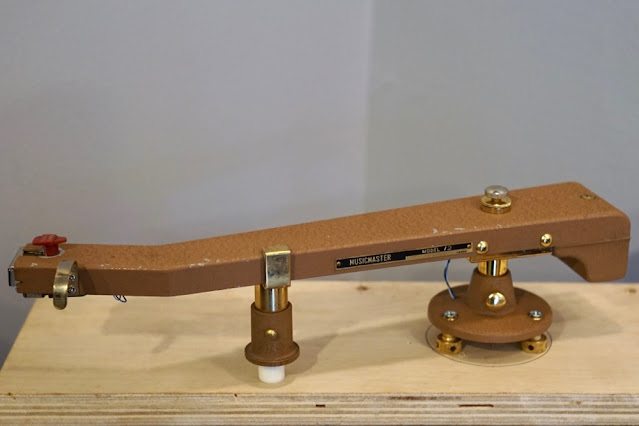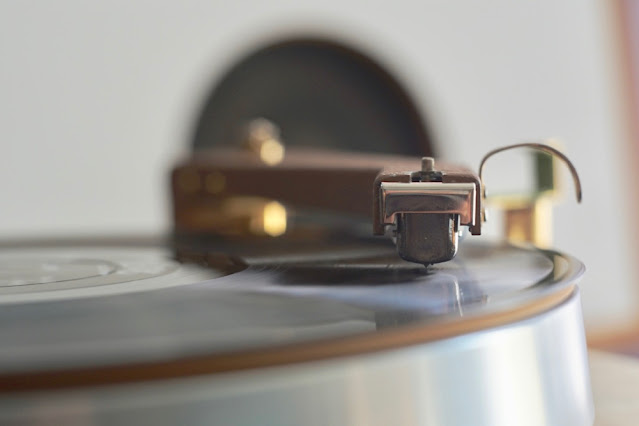Thursday, May 15, 2025
Silbatone Acoustics at the Munich Audio Show 2025
Monday, December 9, 2024
KARMADON 311 Tonearm
In late 2023, Serge Rogozyansky of Karmadon posted his exquisitely crafted Ortofon-inspired 12" tonearm on Facebook. Being an aficionado of bespoked pieces, I was smitten! When I mentioned it to Tish, her immediate reaction was, "You already have too many turntables and tonearms!"😉
Due to an upcoming visit to the Philippines, I had to curb my enthusiasm.
Saturday, March 18, 2023
Musicmaster Model 12 (Gray clone) Tip + GE VRII Hack
 |
| Canon P + Canon 50mm f1.8 Foma 100 in Rodinal 1+50 |
After many decades of collecting and using classic audio equipment and film cameras, I've learned to accept that sometimes I win, sometimes I lose, but most of the time I break even. And the only reason there is that possibility of breaking even is because I learned to DIY.
This tonearm came with a KS Musicmaster Model 25B12GST idler-driven turntable, which I thought I could resuscitate. Alas, the turntable was beyond saving because a lot of important parts were missing. The tonearm had no head shell slide and the cartridge pin contact points + wiring harness were gone. For many years this tonearm was boxed up along with other parts units sitting in storage.
One day I had an epiphany - will the Karmadon head shell slide fit?
I'm happy to report that the two types of head shell slides that my buddy, Sergiy, manufactures for his Gray Research tonearm clone work on this Japanese clone as well as on my original Gray Research 108C. Above left is a solid shell and on the right is a shell with a hole to accommodate the triple play feature of the General Electric RPX and VRII mono cartridges.
Despite the carnage brought upon the Ukrainians by a deranged autocrat, my Karmadon head shells arrived in less than two weeks. We really have to admire and support these people!
I rewired the tonearm and blu-tacked 4 pennies to make up for the lost hardware.
Since the Karmadon head shell slide is lighter than the original, I used all three copper weights Sergiy provided, added 2 x 5 centavo coins + the GE VRII cartridge = 25 grams.
Voila!👍
 |
| For more viscous damped tonearm set up information, please click here! |
Even with my 20+ years of experience using this tonearm, it took me a while to dial-in the proper weight compensation due to the missing hardware + adapted head shell slide. Getting a viscous damped tonearm to function properly isn't for the faint of heart and requires patience. If you don't possess these virtues, I suggest you don't consider using one. But I must say the results are well worth it!😊
 |
| Musicmaster Model 12 + GE VRII |
Let's listen to a few monaural hifi tunes!
🎶🎻🎹🎷
Friday, October 21, 2022
VAS Audio: SPU GME II and Supex SD900 IV retip + Stax UA-3NL and Tokyo Sound ST900 repair
 |
VAS Audio Workshop |
Before lockdown, Ding promised that he'd introduce me to his friend, Steve Leung, of VAS Audio. He's had his Denon DL103S, Ortofon SL15, Supex SD900, and other classic cartridges re-tipped and repaired by Steve. As the pandemic wound down, I finally got to meet Steve and brought the following MC cartridges for new tips, as well as tonearms for repair at his shop.
Ortofon SPU GME MKII
 |
| SPU GME MKII - BEFORE |
 |
| SPU-G |
This SPU-G portrays a wider and airier sonic landscape with perhaps a bit more detail compared to my more recent SPU#1s. It also sounds more organic than the GME MKII.
 |
| SPU GM |
Agreeing to my downgrade idea,😉 Steve may have turned the GME MKII into an SPU-G equivalent of the SPU-A wood. All I know is, it can stand up to my cousin's SPU Synergy!😊
Supex SD900 MKIV
 |
| BEFORE |
 |
| AFTER |
.jpg) |
| SD900 MK IVs (s = spherical) |
Stax UA-3NL
I added the UA-3NL to my collection in early 2018 and paired it with my Thorens TD124 and Sony TTS 2500, respectively. I was going to include this tonearm in my Alfred Bokrand AB309 write-up but one channel dropped out.
When I finally accessed the internal hair-like strands of enameled wire, I realized that repairing it was beyond my DIY abilities.
Similar to the knife-edge bearing'd SME 3012, the Stax presents a mid to back row concert hall perspective, which is an atmospheric experience without any loss of detail. Although I've used it satisfactorily with the SPU#1S, it brings out the best from cartridges that track in the 1.5 > 2.5 gram range. Just like the SME 3012, the UA-3NL may not appeal to listeners who favor a front row seat/kick drum on your chest presentation.
Thanks to Steve's skill and nimble hands, I'm enjoying my UA-3NL again!
Tokyo Sound ST900
This 9" tonearm from the early 60s has an NHK broadcasting heritage. Comprehensive information about the ST900 is available at audio-heritage.jp. Surprisingly, the spindle to pivot mounting distance wasn't specified.
So I took out my ancient Cart-Align protractor, did some measurements with my Ortofon SPU#1s cartridge attached and got a pivot to spindle distance of 223mm. I haven't had any problems with cartridges I installed conforming to the SPU's overhang.
Claus Volke and this Japanese audio blog have more to say about this tonearm.
The design may have been inspired by the Ortofon SMG212 and SKG212 with added Japanese innovations. It is quite massive and can easily balance a 30+ gram SPU. So far the lightest cartridge/head shell combo I used successfully was 19.5 grams. Given its high tolerance bearings, it's an ideal partner to the Denon DL103, Ortofon SPU, and similar low compliance cartridges. Consider this as an excellent alternative to the classic Ortofon AS/RM/SK/SMG 212 series tonearms especially if you prefer the svelte proportions of a compact plinth!
iPhone video clips of the MC cartridges and tonearms in action
 |
| Steve, the master craftsman, and Ding |
Looking forward to Steve's visit to the man cave!🍻
Friday, June 3, 2022
Fidelity Research FR64fx - dead channel fix
Thursday, August 19, 2021
Gray Research HF500 Turntable + 108C Tonearm
My buddy John Piro has a knack for finding obscure vintage hifi pieces and has built up quite a collection. A couple of summers ago, he offered his spare blonde plinthed HF500.
I had just acquired my first and only genuine Gray Research 108C viscous damped tonearm and couldn't pass up the opportunity to pair them up.
 |
| Capstan Drive |
 |
| 45 + 78 rpm capstans |
 |
| D&R turntable drive system Courtesy of jamesvanarsdale.com |
 |
| Seiko-Epson drive system Courtesy of audio-heritage.jp |
Servicing Tips
Disassembly
Removing the motor
 |
| Left = worn out motor mounts Right = fresh motor mounts |




































